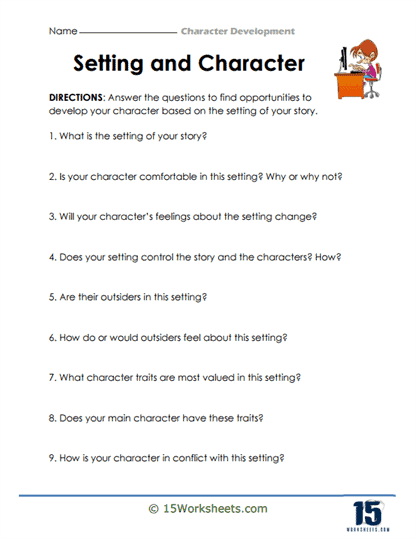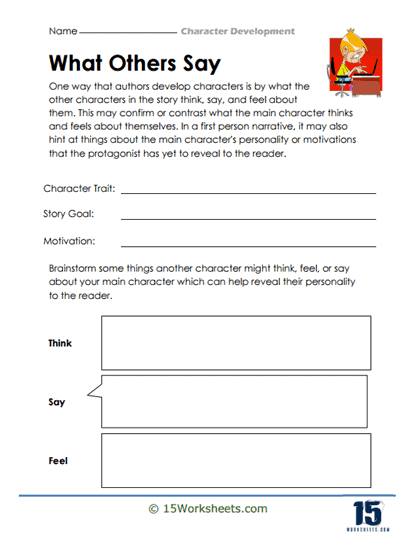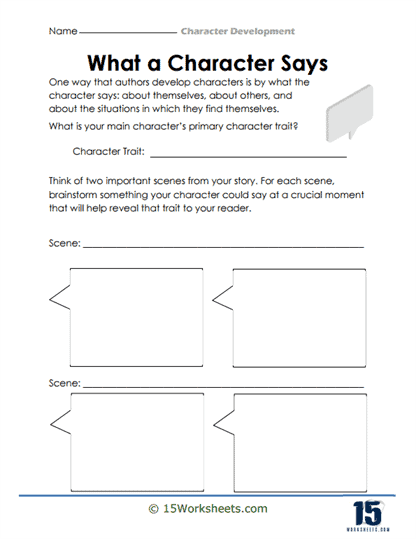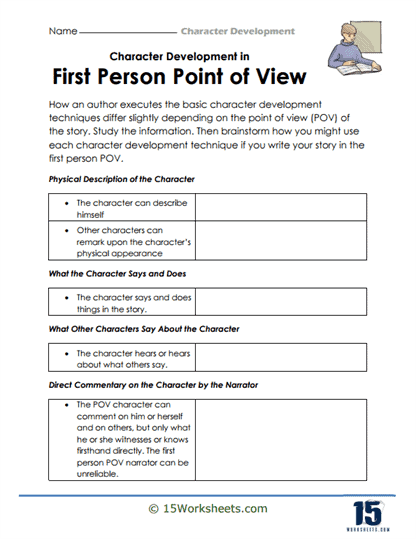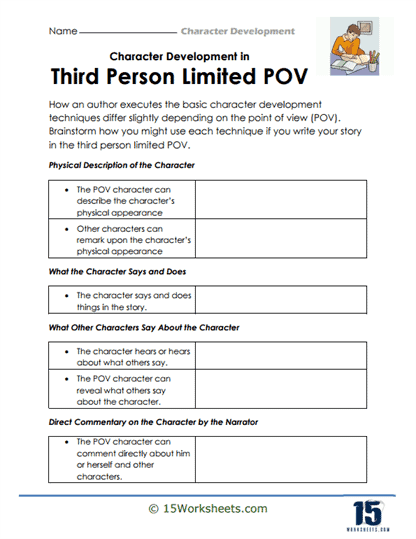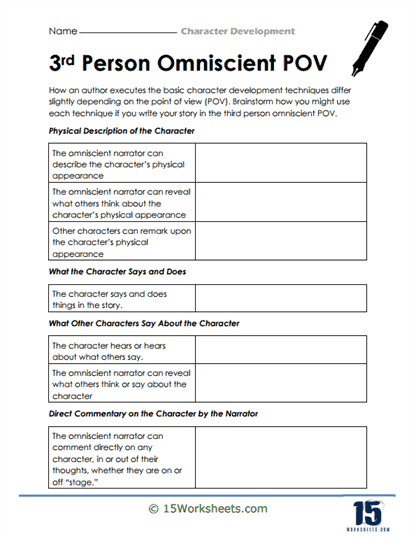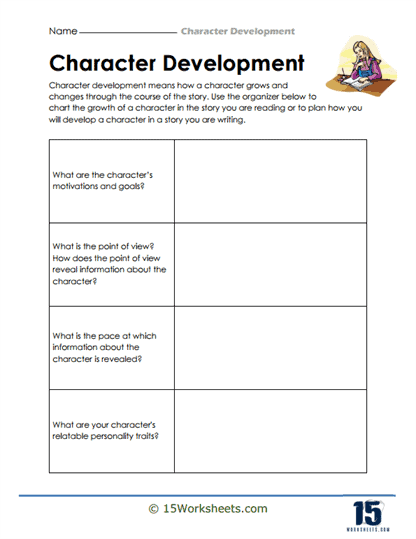Character Development Worksheets
About These 15 Worksheets
Ah, the whimsical world of character development worksheets-a place where fictional personalities are sculpted with the precision of a master chef crafting a soufflé. Let’s embark on a delightful journey through these educational tools that transform students into character connoisseurs.
First up, we have the foundational exercises like “Four Main Ways,” which prompt students to dissect their characters’ physical appearances, actions, dialogues, and the perceptions of others. It’s akin to a detective’s dossier, minus the magnifying glass. “Physical Appearance” encourages budding writers to detail everything from a character’s hairstyle to their choice of footwear-because, as we all know, a villain in bunny slippers is a plot twist waiting to happen.
Venturing further, “Setting and Character” and “Branching Out” challenge students to consider how environments shape personalities. Imagine a character raised in a library versus one from a circus; the possibilities are endless and amusing. “On The Spectrum” adds another layer, inviting students to place characters along various trait continuums-because who doesn’t love a good personality chart?
Delving into the psyche, “A Close Look,” “What Others Say,” and “Character’s Dialogue” push students to explore internal conflicts and external perceptions. It’s like therapy for fictional beings, sans the hourly rate. “In The Face Of Conflict” adds drama, prompting students to throw their characters into challenging scenarios-because nothing says growth like a dragon attack or an unexpected pop quiz.
Finally, perspective is everything. “First Person,” “Third Person Limited POV,” and “Omniscient POV” allow students to experiment with narrative voices, turning them into literary ventriloquists. “Chart The Growth” wraps it all up by encouraging students to map out their characters’ development arcs, ensuring that even the most static of characters find their moment to shine-or at least trip over something comically.
In essence, these worksheets are more than just academic exercises; they’re a playground for the imagination, where students can craft, critique, and chuckle their way through the art of character creation. So, grab a pencil, unleash your inner storyteller, and remember: every great character starts with a well-thought-out worksheet.
These worksheets can be utilized in a variety of ways such as:
Creative Writing – For aspiring writers, character development worksheets can help in creating well-rounded and believable characters. The worksheet may include prompts to flesh out a character’s physical appearance, personality traits, background, motives, strengths, weaknesses, etc.
Literature Studies – In literature classes, these worksheets can be used to analyze characters in novels, short stories, plays, etc. Students can dissect a character’s actions, words, and motivations to understand the character’s role in the narrative and their impact on the story’s events.
Drama/Theater – In drama or theater studies, students can use these worksheets to understand their character’s motives and background, which can help them portray their character more effectively.
Psychology – In psychology, character development worksheets can be used to understand different personality types, behaviors, and motivations.
What is Character Development?
Character development, in the context of storytelling and writing, refers to the process through which a character undergoes changes and growth throughout the narrative, transforming in response to the experiences and events they encounter. This development makes a character feel more real, relatable, and dynamic to the audience.
It can take many forms:
Change in Perspective – A character might start the story with a certain set of beliefs or perspectives, and through their experiences, they come to see things differently. For instance, Ebenezer Scrooge in Charles Dickens’ “A Christmas Carol” begins as a miserly character with a dislike for festivity and an uncaring attitude towards others. However, through ghostly interventions and reflections on his past, present, and future, his perspective drastically changes, leading him to become kind, generous, and celebratory by the end.
Emotional Growth – A character may evolve emotionally through the course of the narrative. For example, in the “Harry Potter” series, Harry starts as an unloved orphan living under the stairs at his aunt and uncle’s house. Through his experiences at Hogwarts and in the wizarding world, he learns about love, friendship, courage, and self-sacrifice, growing emotionally and becoming a hero.
Acquiring New Skills – A character might develop by gaining new abilities or knowledge that they didn’t have at the start of the story. For example, in “The Hunger Games” series, Katniss Everdeen grows from being a skilled hunter and survivalist in her district to becoming a symbol of rebellion and a skilled public speaker and strategist in the rebellion against the Capitol.
Overcoming Flaws – Sometimes, a character starts with certain flaws or shortcomings and overcomes these through their journey. In Jane Austen’s “Pride and Prejudice”, Elizabeth Bennet and Mr. Darcy both undergo this type of development. Elizabeth starts off as being quick to judge, forming a negative opinion about Mr. Darcy, while Mr. Darcy is initially proud and aloof. As the story unfolds, both characters recognize and overcome their flaws, leading to their eventual understanding and love for each other.
Coping with Trauma or Loss – In some narratives, characters develop through dealing with traumatic experiences or losses. For instance, in “The Lord of the Rings”, Frodo Baggins evolves from a simple, carefree hobbit to a burdened carrier of the One Ring, ultimately coping with immense loss and trauma, changing significantly by the journey’s end.
Remember, character development can take many shapes depending on the story’s context, and it is not always positive. Sometimes characters may devolve, reflecting a decline or regression, which can be just as significant for the narrative.
What are the Different Types of Character Development?
Static vs. Dynamic Characters
Static Characters – These are characters who do not undergo significant changes throughout the story. They remain largely the same from the beginning to the end. Their beliefs, attitudes, or personalities don’t transform in substantial ways. An example of a static character could be Sherlock Holmes, who remains a consistently brilliant and eccentric detective throughout Arthur Conan Doyle’s stories.
Dynamic Characters – These are characters who undergo significant changes throughout the narrative. This change could be in their beliefs, attitudes, or behaviors, and is usually a result of the events or experiences they go through in the story. An example of a dynamic character is Ebenezer Scrooge from Charles Dickens’ “A Christmas Carol.”
Flat vs. Round Characters
Flat Characters – Flat characters are typically two-dimensional, simple, and not very detailed. They’re often used to serve specific purposes in the story, and they do not go through substantial development or change. For example, in a detective novel, a flat character might be a minor character who only appears briefly and doesn’t undergo significant development.
Round Characters – Round characters are complex and detailed, often with varied traits, conflicts, and development. They typically have multiple dimensions to their personality, and they evolve in response to the events of the narrative. An example of a round character is Harry Potter, who is portrayed with a complex personality and undergoes significant growth and change throughout J.K. Rowling’s series.






